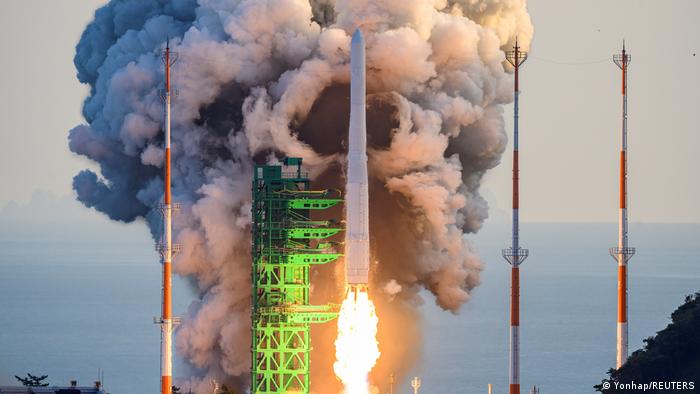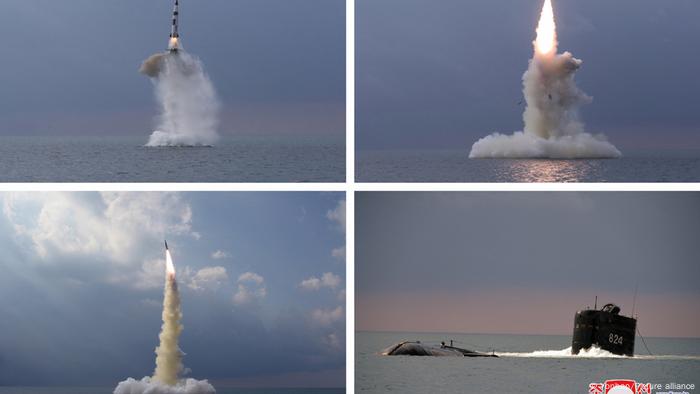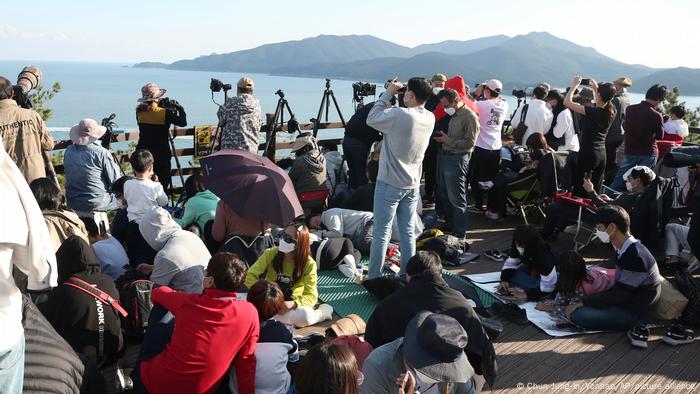SPACE RACE 2.0
S Korea test launches 1st domestically made By KIM TONG-HYUNG

1 of 6
In this photo provided by Korea Aerospace Research Institute via Yonhap, the Nuri rocket, the first domestically produced space rocket, sits on its launch pad at the Naro Space Center in Goheung, South Korea, Wednesday, Oct. 20, 2021. South Korea was preparing to test-launch its first domestically produced space rocket Thursday, Oct.21, in what officials describe as an important step in its pursuit of a satellite launch program.
(Korea Aerospace Research Institute/Yonhap via AP)
SEOUL, South Korea (AP) — South Korea test launched its first domestically produced space rocket on Thursday in what officials describe as an important step in the country’s pursuit of a satellite launch program.
It wasn’t immediately clear whether the three-stage Nuri rocket succeeded in delivering a dummy payload – a 1.5-ton block of stainless steel and aluminum – into orbit 600 to 800 kilometers (372 to 497 miles) above Earth.
Live footage showed the 47-meter (154 foot) rocket soaring into the air with bright yellow flames shooting out of its engines following blastoff at Naro Space Center, the country’s lone spaceport, on a small island off its southern coast.
The launch, which was observed by South Korean President Moon Jae-in, was delayed by an hour because engineers needed more time to examine the rocket’s valves. There had also been concerns that strong winds and other conditions would pose challenges for a successful launch.
Officials at the Korea Aerospace Research Institute, the country’s space agency, said it would take about 30 minutes to determine whether the rocket successfully delivered the payload into orbit.
SEOUL, South Korea (AP) — South Korea test launched its first domestically produced space rocket on Thursday in what officials describe as an important step in the country’s pursuit of a satellite launch program.
It wasn’t immediately clear whether the three-stage Nuri rocket succeeded in delivering a dummy payload – a 1.5-ton block of stainless steel and aluminum – into orbit 600 to 800 kilometers (372 to 497 miles) above Earth.
Live footage showed the 47-meter (154 foot) rocket soaring into the air with bright yellow flames shooting out of its engines following blastoff at Naro Space Center, the country’s lone spaceport, on a small island off its southern coast.
The launch, which was observed by South Korean President Moon Jae-in, was delayed by an hour because engineers needed more time to examine the rocket’s valves. There had also been concerns that strong winds and other conditions would pose challenges for a successful launch.
Officials at the Korea Aerospace Research Institute, the country’s space agency, said it would take about 30 minutes to determine whether the rocket successfully delivered the payload into orbit.


The Nuri rocket, the first domestically produced space rocket, lifts off from a launch pad at the Naro Space Center in Goheung, South Korea, Thursday, Oct. 21, 2021
Nuri’s largest first stage, the core booster stage, was expected to land in waters southwest of Japan after separation, and its second stage was expected to fall in remote Pacific waters east of the Philippines, about 2,800 kilometers (1,740 miles) away from the launch site. The smallest third stage carries the payload and is designed to place it into orbit.
After relying on other countries to launch its satellites since the early 1990s, South Korea is now trying to become the 10th nation to send a satellite into space with its own technology.
Officials say such an ability would be crucial for the country’s space ambitions, which include plans for sending more advanced communications satellites and acquiring its own military intelligence satellites. The country is also hoping to send a probe to the moon by 2030.
Nuri is the country’s first space launch vehicle built entirely with domestic technology. The three-stage rocket is powered by five 75-ton class rocket engines placed in its first and second stages.
Scientists and engineers at KARI plan to test Nuri several more times, including conducting another launch with a dummy device in May 2022, before trying with a real satellite.
South Korea had previously launched a space launch vehicle from the Naro spaceport in 2013, which was a two-stage rocket built mainly with Russian technology. That launch came after years of delays and consecutive failures. The rocket, named Naro, reached the desired altitude during its first test in 2009 but failed to eject a satellite into orbit, and then exploded shortly after takeoff during its second test in 2010.
It wasn’t clear how North Korea, which had been accused of using its space launch attempts in past years as a disguise for developing long-range missile technology, would react to Thursday’s launch.
While pushing to expand its nuclear and missile program, the North had shown sensitivity about South Korea’s increasing defense spending and efforts to build more powerful conventionally armed missiles.
In a speech to Pyongyang’s rubber-stamp parliament last month, North Korean leader Kim Jong Un accused the U.S. and South Korea of “destroying the stability and balance” in the region with their allied military activities and a U.S.-led “excessive arms buildup” in the South.
While Nuri is powered by liquid propellants that need to be fueled shortly before launch, the South Koreans plan to develop a solid-fuel space launch rocket by 2024, which possibly could be prepared for launch more quickly and also be more cost effective.
South Korea space rocket test prompts fear of arms race with North
Tensions between Seoul and Pyongyang have grown in recent months. South Korea's failed test of its first-ever homegrown rocket has prompted worries of a new arms race.

South Korea has launched a Nuri rocket from the launch pad of its Naro Space Center in Goheung, South Korea
Shortly after 5 p.m. local time (0800 UTC) on Thursday, South Korea launched its first domestically produced rocket from the Naro Space Center in the northeastern county of Goheung.
All three stages of the liquid-fueled Nuri rocket, which cost around 2 trillion won ($1.7 billion, €1.46 billion), worked but the rocket reportedly failed to complete the mission of delivering a test satellite into orbit.
South Korean President Moon Jae-in said the rocket reached an altitude of 700 kilometers (435 miles), and that the 1.5 ton payload separated successfully.
However, Moon said that "putting a dummy satellite into orbit remains an unfinished mission."
Despite the test being unable to fulfill its task of putting a satellite into orbit, the launch comes as South Korea is locked into a growing rivalry with North Korea over technological advances in weaponry.
South Korean President Moon Jae-in called the test an "excellent accomplishment,'' taking South Korea a step further toward a space launch program.
North Korea submarine missile test was planned, experts think
South Korea's launch of the Nuri rocket has long been planned. Analysts said it was no coincidence that North Korea on Tuesday carried out what it claims was the first launch of a ballistic missile from a submerged submarine (SLBM).
The test launch was conducted off the naval base on the west coast of the peninsula. It was the eighth time that the North has carried out a missile launch this year.
It also coincided with the five-day Seoul International Aerospace and Defense Exhibition, where South Korean President Moon Jae-in was pictured in a flight suit and in the cockpit of a domestically produced FA-50 fighter jet.
Speaking to reporters, Moon said it is imperative for South Korea to build up its defenses: "A strong defense capability is always aimed at ensuring peace."
"The Republic of Korea seeks to build a smart and strong armed forces based on state-of-the-art technology," he added.
North justifies military buildup
Exactly one week earlier, North Korean leader Kim Jong-un attended a defense development exhibition in the North's capital Pyongyang to mark the 76th anniversary of the founding of the Workers' Party, issuing a similar justification for his own military buildup.
"We must be powerful for our coming generations as well," the state-run Korea Central News Agency (KCNA) quoted Kim as saying. "That is our first and foremost task."
"The military danger facing our state daily to the military tension prevailing around the Korean peninsula is different from 10 or five, even three years ago," he said.
Kim blamed "the unstable situation in the region" on the United States.

North Korea confirmed it had tested a new type of submarine-launched ballistic missile
In late September, the North tested what it claimed was an advanced new hypersonic missile.
US defense analysis suggests that Pyongyang may resume underground nuclear tests or fire a long-range ballistic missile within the next year.
Both would be violations of United Nations Security Council resolutions. But Pyongyang insists that its military developments are purely defensive and necessary as its enemies — primarily the US, South Korea and Japan — remain committed to overthrow of the Kim regime.
Those countries deny that they are planning a regime change in North Korea. But they all point out that they cannot sit by as a nuclear-armed and deeply unpredictable neighbor continues to build out its military capabilities.
South Korea tested its own submarine-launched ballistic missile recently, and is investing heavily in improved equipment on land, sea and air.
Significantly, the Korean navy is pushing ahead with plans to build the nation's first aircraft carrier. Meanwhile, discussions are also underway about the possibility of developing a nuclear-powered submarine.
North Korea 'careful not to cross red lines'
"The North just tested its first hypersonic missile and has now launched an SLBM, so it seems that they are showing the South and the rest of the world just what they can do," said June Park, a political economist with Princeton University.
"South Korea cannot just sit by and let that happen, so the Seoul defense show is a chance to demonstrate, 'we also have the ability to defend ourselves,'" she told DW.
Robert Dujarric, co-director of the Institute of Contemporary Asian Studies at the Tokyo campus of Temple University, says there has been an uptick in saber-rattling after a period of relative restraint on the Korean Peninsula. But he said Pyongyang is very aware where the "red line" lies.
"Ever since the armistice at the end of the Korean War in 1953, we have seen these periodic bouts of development of new weapons in the North — such as nuclear tests and then intercontinental ballistic missile launches — but the North has been very careful to not go too far, to not cross any red lines," he said.
"They have caused small-scale border incidents and been provocative and made a nuisance of themselves — but they have never gone too far as they know that crossing that red line would bring down a massive US retaliation," he said.
Just a phase?
"I think we are in that cycle again, and it must be remembered that it is one thing to parade a new missile through Pyongyang or to carry out a test launch, but it's an entirely different thing to fire one of these things in an operational situation," Park explained.
Unfortunately, says Park, the North's development of nuclear weapons gives the South little leeway in where to advance its own military capabilities in the years to come.
South Korean people are split almost half-and-half on the question of whether or not to develop a domestic nuclear deterrent, she said.
Should that happen, however, the reverberations would be felt far beyond North Korea and could arguably destabilize the entire northeast Asian region, where Russia, China and Japan are also major powers, Park explained.
Tensions between Seoul and Pyongyang have grown in recent months. South Korea's failed test of its first-ever homegrown rocket has prompted worries of a new arms race.

South Korea has launched a Nuri rocket from the launch pad of its Naro Space Center in Goheung, South Korea
Shortly after 5 p.m. local time (0800 UTC) on Thursday, South Korea launched its first domestically produced rocket from the Naro Space Center in the northeastern county of Goheung.
All three stages of the liquid-fueled Nuri rocket, which cost around 2 trillion won ($1.7 billion, €1.46 billion), worked but the rocket reportedly failed to complete the mission of delivering a test satellite into orbit.
South Korean President Moon Jae-in said the rocket reached an altitude of 700 kilometers (435 miles), and that the 1.5 ton payload separated successfully.
However, Moon said that "putting a dummy satellite into orbit remains an unfinished mission."
Despite the test being unable to fulfill its task of putting a satellite into orbit, the launch comes as South Korea is locked into a growing rivalry with North Korea over technological advances in weaponry.
South Korean President Moon Jae-in called the test an "excellent accomplishment,'' taking South Korea a step further toward a space launch program.
North Korea submarine missile test was planned, experts think
South Korea's launch of the Nuri rocket has long been planned. Analysts said it was no coincidence that North Korea on Tuesday carried out what it claims was the first launch of a ballistic missile from a submerged submarine (SLBM).
The test launch was conducted off the naval base on the west coast of the peninsula. It was the eighth time that the North has carried out a missile launch this year.
It also coincided with the five-day Seoul International Aerospace and Defense Exhibition, where South Korean President Moon Jae-in was pictured in a flight suit and in the cockpit of a domestically produced FA-50 fighter jet.
Speaking to reporters, Moon said it is imperative for South Korea to build up its defenses: "A strong defense capability is always aimed at ensuring peace."
"The Republic of Korea seeks to build a smart and strong armed forces based on state-of-the-art technology," he added.
North justifies military buildup
Exactly one week earlier, North Korean leader Kim Jong-un attended a defense development exhibition in the North's capital Pyongyang to mark the 76th anniversary of the founding of the Workers' Party, issuing a similar justification for his own military buildup.
"We must be powerful for our coming generations as well," the state-run Korea Central News Agency (KCNA) quoted Kim as saying. "That is our first and foremost task."
"The military danger facing our state daily to the military tension prevailing around the Korean peninsula is different from 10 or five, even three years ago," he said.
Kim blamed "the unstable situation in the region" on the United States.

North Korea confirmed it had tested a new type of submarine-launched ballistic missile
In late September, the North tested what it claimed was an advanced new hypersonic missile.
US defense analysis suggests that Pyongyang may resume underground nuclear tests or fire a long-range ballistic missile within the next year.
Both would be violations of United Nations Security Council resolutions. But Pyongyang insists that its military developments are purely defensive and necessary as its enemies — primarily the US, South Korea and Japan — remain committed to overthrow of the Kim regime.
Those countries deny that they are planning a regime change in North Korea. But they all point out that they cannot sit by as a nuclear-armed and deeply unpredictable neighbor continues to build out its military capabilities.
South Korea tested its own submarine-launched ballistic missile recently, and is investing heavily in improved equipment on land, sea and air.
Significantly, the Korean navy is pushing ahead with plans to build the nation's first aircraft carrier. Meanwhile, discussions are also underway about the possibility of developing a nuclear-powered submarine.
North Korea 'careful not to cross red lines'
"The North just tested its first hypersonic missile and has now launched an SLBM, so it seems that they are showing the South and the rest of the world just what they can do," said June Park, a political economist with Princeton University.
"South Korea cannot just sit by and let that happen, so the Seoul defense show is a chance to demonstrate, 'we also have the ability to defend ourselves,'" she told DW.
Robert Dujarric, co-director of the Institute of Contemporary Asian Studies at the Tokyo campus of Temple University, says there has been an uptick in saber-rattling after a period of relative restraint on the Korean Peninsula. But he said Pyongyang is very aware where the "red line" lies.
"Ever since the armistice at the end of the Korean War in 1953, we have seen these periodic bouts of development of new weapons in the North — such as nuclear tests and then intercontinental ballistic missile launches — but the North has been very careful to not go too far, to not cross any red lines," he said.
"They have caused small-scale border incidents and been provocative and made a nuisance of themselves — but they have never gone too far as they know that crossing that red line would bring down a massive US retaliation," he said.
Just a phase?
"I think we are in that cycle again, and it must be remembered that it is one thing to parade a new missile through Pyongyang or to carry out a test launch, but it's an entirely different thing to fire one of these things in an operational situation," Park explained.
Unfortunately, says Park, the North's development of nuclear weapons gives the South little leeway in where to advance its own military capabilities in the years to come.
South Korean people are split almost half-and-half on the question of whether or not to develop a domestic nuclear deterrent, she said.
Should that happen, however, the reverberations would be felt far beyond North Korea and could arguably destabilize the entire northeast Asian region, where Russia, China and Japan are also major powers, Park explained.

No comments:
Post a Comment